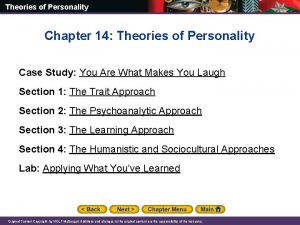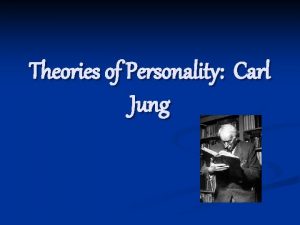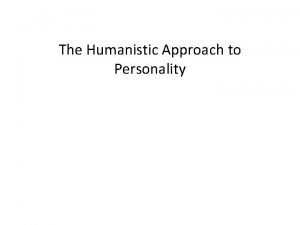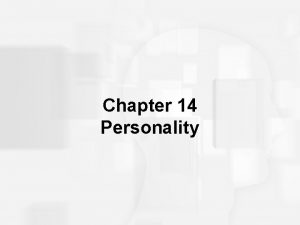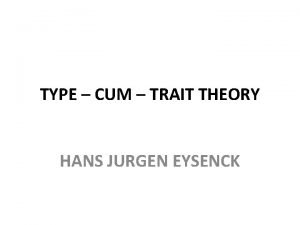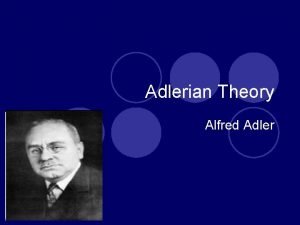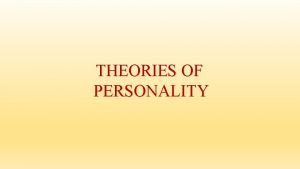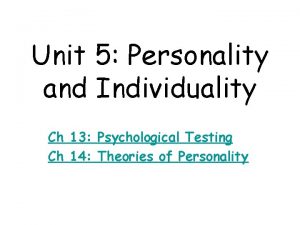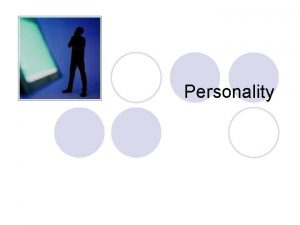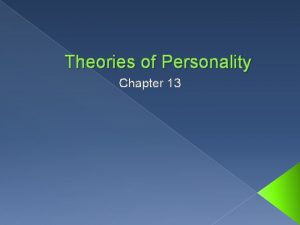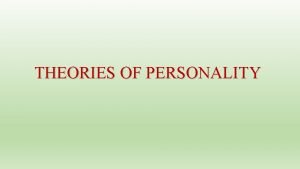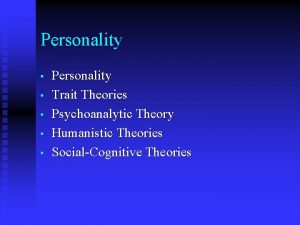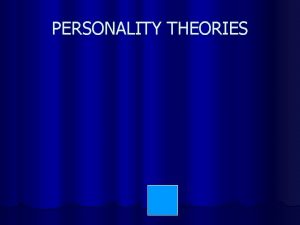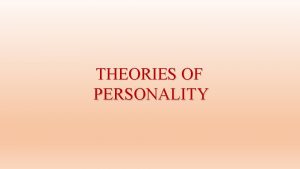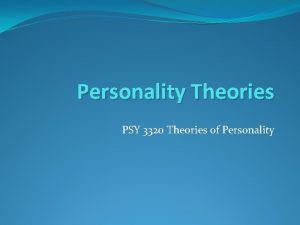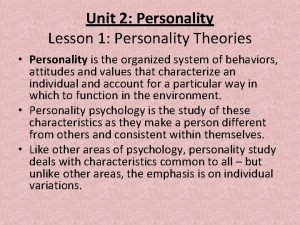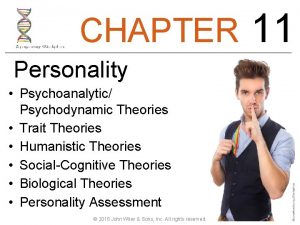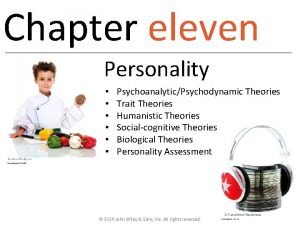Theories of Personality Chapter 11 Personality Personality the
























- Slides: 24

Theories of Personality Chapter 11

Personality • Personality - the unique and relatively stable ways in which people think, feel, and behave. • Character - value judgments of a person’s moral and ethical behavior. • Temperament - the enduring characteristics with which each person is born. Copyright © 2011 Pearson Education, Inc. All rights reserved. Menu

Four Perspectives in Study of Personality • Psychoanalytic • Behavioristic (including social cognitive theory) • Humanistic • Trait perspectives Copyright © 2011 Pearson Education, Inc. All rights reserved. Menu

Behaviorism and Personality • Behaviorists define personality as a set of learned responses or habits. • Habits - in behaviorism, sets of well-learned responses that have become automatic. • Social cognitive learning theorists – theorists who emphasize the importance of both the influences of other people’s behavior and of a person’s own expectancies on learning. • Social cognitive view – learning theory that includes cognitive processes such as anticipating, judging, memory, and imitation of models. Copyright © 2011 Pearson Education, Inc. All rights reserved. Menu

Behaviorism and Personality • Reciprocal determinism - Bandura’s explanation of how the factors of environment, personal characteristics, and behavior can interact to determine future behavior. • Self-efficacy – individual’s perception of how effective a behavior will be in any particular circumstance (NOT the same as self-esteem). Copyright © 2011 Pearson Education, Inc. All rights reserved. Menu

Menu Copyright © 2011 Pearson Education, Inc. All rights reserved.

Individuals & Environments Specific ways in which individuals and environments interact Different people choose different The school you attend and the environments. music you listen to are partly based on your dispositions. Our personalities shape how we react to events. Our personalities shape situations. Anxious people react to situations differently than calm people. How we view and treat people influences how they treat us.

Behavior emerges from an interplay of external and internal influences.

Rotter’s Social Learning Theory • People are motivated to seek reinforcement and avoid punishment • Locus of control (LOC) refers to people’s tendency to assume that they either do or do not have control over events in their lives • Internal LOC: People assume their actions and decisions affect their experiences • External LOC: People assume their lives are controlled by powerful others, luck, or fate Copyright © 2011 Pearson Education, Inc. All rights reserved.

Personal Control Social-cognitive psychologists emphasize our sense of personal control, whether we control the environment or the environment controls us. External locus of control refers to the perception that chance or outside forces beyond our personal control determine our fate. Internal locus of control refers to the perception that we can control our own fate.

Humanistic Theories of Personality • Humanistic perspective - the “third force” in psychology that focuses on those aspects of personality that make people uniquely human, such as subjective feelings and freedom of choice. • Developed as a reaction against the negativity of psychoanalysis and the deterministic nature of behaviorism. Copyright © 2011 Pearson Education, Inc. All rights reserved. Menu

Roger’s Theory of Personality • Self-actualizing tendency – the striving to fulfill one’s innate capacities and capabilities. • Self-concept - the image of oneself that develops from interactions with important, significant people in one’s life. • Self - archetype that works with the ego to manage other archetypes and balance the personality. • Real self - one’s perception of actual characteristics, traits, and abilities. • Ideal self - one’s perception of whom one should be or would like to be. Copyright © 2011 Pearson Education, Inc. All rights reserved. Menu

Menu Copyright © 2011 Pearson Education, Inc. All rights reserved.

Roger’s Theory of Personality • Positive regard – warmth, affection, love, and respect that come from significant others in one’s life. • Unconditional positive regard - positive regard that is given without conditions or strings attached. • Conditional positive regard- positive regard that is given only when the person is doing what the providers of positive regard wish. • Fully functioning person – a person who is in touch with and trusting of the deepest, innermost urges and feelings. Menu Copyright © 2011 Pearson Education, Inc. All rights reserved.

Measuring Personality: Interviews • Interview - method of personality assessment in which the professional asks questions of the client and allows the client to answer, either in a structured or unstructured fashion. • Halo effect – tendency of an interviewer to allow positive characteristics of a client to influence the assessments of the client’s behavior and statements. Copyright © 2011 Pearson Education, Inc. All rights reserved. Menu

Measuring Personality: Projective Tests • Projection - defense mechanism involving placing, or “projecting, ” one’s own unacceptable thoughts onto others, as if the thoughts actually belonged to those others and not to oneself. • Projective tests – personality assessments that present ambiguous visual stimuli to the client and ask the client to respond with whatever comes to mind. • Rorschach inkblot test - projective test that uses 10 inkblots as the ambiguous stimuli. • Thematic Apperception Test (TAT) - projective test that uses 20 pictures of people in ambiguous situations as the visual stimuli. • Subjective - concepts and impressions that are only valid within a particular person’s perception and may be influenced by biases, prejudice, and personal experiences. This is a problem with projective tests. Menu Copyright © 2011 Pearson Education, Inc. All rights reserved.

Copyright © 2011 Pearson Education, Inc. All rights reserved. Menu


Thematic Apperception Test (TAT) Developed by Henry Murray, the TAT is a projective test in which people express their inner feelings and interests through the stories they make up about ambiguous scenes. Lew Merrim/ Photo Researcher, Inc.

Menu Copyright © 2011 Pearson Education, Inc. All rights reserved.


Measuring Personality: Behavioral Measures • Direct observation – assessment in which the professional observes the client engaged in ordinary, day-to-day behavior in either a clinical or natural setting. • Rating scale- assessment in which a numerical value is assigned to specific behavior that is listed in the scale. • Frequency count – assessment in which the frequency of a particular behavior is counted. Copyright © 2011 Pearson Education, Inc. All rights reserved. Menu

Measuring Personality: Personality Inventory • Personality inventory - paper and pencil or computerized test that consists of statements that require a specific, standardized response from the person taking the test. • NEO-PI - based on the five-factor model • Myers-Briggs Type Indicator - based on Jung’s theory of personality types. • MMPI-2 - designed to detect abnormal personality. Copyright © 2011 Pearson Education, Inc. All rights reserved. Menu

Personality Tests and Internet • There are numerous personality tests available on the Internet. • Not all equal in quality, reliability, or validity. • Lack of professional interpretation of the results of such tests. Copyright © 2011 Pearson Education, Inc. All rights reserved. Menu
 Chapter 14 theories of personality
Chapter 14 theories of personality According to jung the unconscious mind is characterized by
According to jung the unconscious mind is characterized by Carl rogers mbti
Carl rogers mbti Freudian personality test
Freudian personality test Trait theory in consumer behaviour
Trait theory in consumer behaviour Trait theory eysenck
Trait theory eysenck Strengths and weaknesses of adlerian therapy
Strengths and weaknesses of adlerian therapy Personality theories
Personality theories Trait theories of personality _____.
Trait theories of personality _____. L
L Hát kết hợp bộ gõ cơ thể
Hát kết hợp bộ gõ cơ thể Lp html
Lp html Bổ thể
Bổ thể Tỉ lệ cơ thể trẻ em
Tỉ lệ cơ thể trẻ em Gấu đi như thế nào
Gấu đi như thế nào Chụp tư thế worms-breton
Chụp tư thế worms-breton Alleluia hat len nguoi oi
Alleluia hat len nguoi oi Môn thể thao bắt đầu bằng từ chạy
Môn thể thao bắt đầu bằng từ chạy Thế nào là hệ số cao nhất
Thế nào là hệ số cao nhất Các châu lục và đại dương trên thế giới
Các châu lục và đại dương trên thế giới Công thức tính thế năng
Công thức tính thế năng Trời xanh đây là của chúng ta thể thơ
Trời xanh đây là của chúng ta thể thơ Cách giải mật thư tọa độ
Cách giải mật thư tọa độ Làm thế nào để 102-1=99
Làm thế nào để 102-1=99 Phản ứng thế ankan
Phản ứng thế ankan
